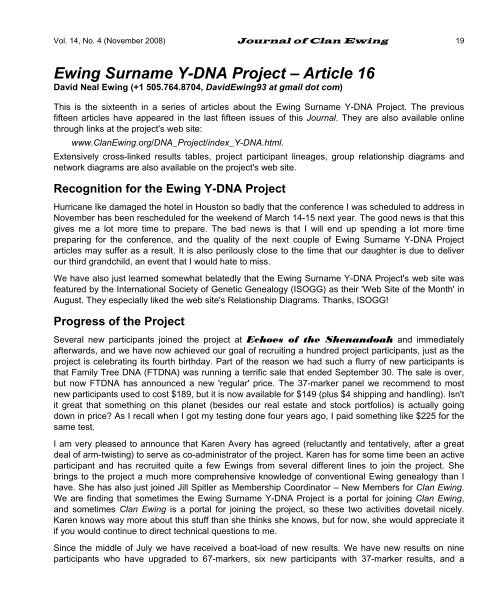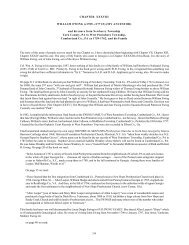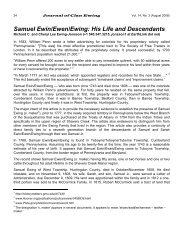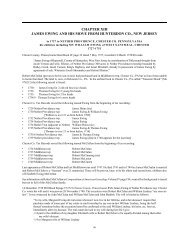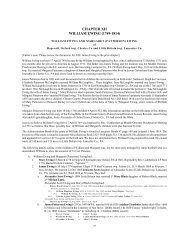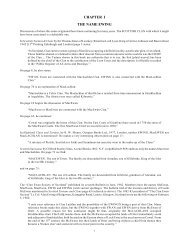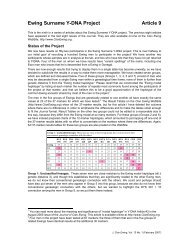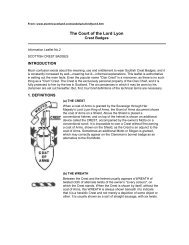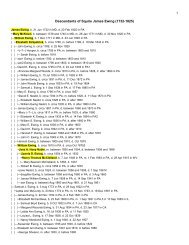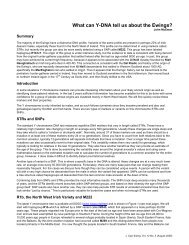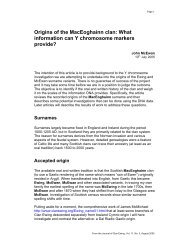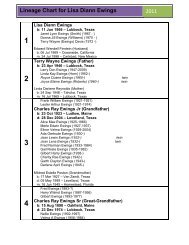Ewing Surname Y-DNA Project – Article 16 - Ewing Family Association
Ewing Surname Y-DNA Project – Article 16 - Ewing Family Association
Ewing Surname Y-DNA Project – Article 16 - Ewing Family Association
You also want an ePaper? Increase the reach of your titles
YUMPU automatically turns print PDFs into web optimized ePapers that Google loves.
Vol. 14, No. 4 (November 2008) Journal of Clan <strong>Ewing</strong> 19<br />
<strong>Ewing</strong> <strong>Surname</strong> Y-<strong>DNA</strong> <strong>Project</strong> <strong>–</strong> <strong>Article</strong> <strong>16</strong><br />
David Neal <strong>Ewing</strong> (+1 505.764.8704, David<strong>Ewing</strong>93 at gmail dot com)<br />
This is the sixteenth in a series of articles about the <strong>Ewing</strong> <strong>Surname</strong> Y-<strong>DNA</strong> <strong>Project</strong>. The previous<br />
fifteen articles have appeared in the last fifteen issues of this Journal. They are also available online<br />
through links at the project's web site:<br />
www.Clan<strong>Ewing</strong>.org/<strong>DNA</strong>_<strong>Project</strong>/index_Y-<strong>DNA</strong>.html.<br />
Extensively cross-linked results tables, project participant lineages, group relationship diagrams and<br />
network diagrams are also available on the project's web site.<br />
Recognition for the <strong>Ewing</strong> Y-<strong>DNA</strong> <strong>Project</strong><br />
Hurricane Ike damaged the hotel in Houston so badly that the conference I was scheduled to address in<br />
November has been rescheduled for the weekend of March 14-15 next year. The good news is that this<br />
gives me a lot more time to prepare. The bad news is that I will end up spending a lot more time<br />
preparing for the conference, and the quality of the next couple of <strong>Ewing</strong> <strong>Surname</strong> Y-<strong>DNA</strong> <strong>Project</strong><br />
articles may suffer as a result. It is also perilously close to the time that our daughter is due to deliver<br />
our third grandchild, an event that I would hate to miss.<br />
We have also just learned somewhat belatedly that the <strong>Ewing</strong> <strong>Surname</strong> Y-<strong>DNA</strong> <strong>Project</strong>'s web site was<br />
featured by the International Society of Genetic Genealogy (ISOGG) as their 'Web Site of the Month' in<br />
August. They especially liked the web site's Relationship Diagrams. Thanks, ISOGG!<br />
Progress of the <strong>Project</strong><br />
Several new participants joined the project at Echoes of the Shenandoah and immediately<br />
afterwards, and we have now achieved our goal of recruiting a hundred project participants, just as the<br />
project is celebrating its fourth birthday. Part of the reason we had such a flurry of new participants is<br />
that <strong>Family</strong> Tree <strong>DNA</strong> (FT<strong>DNA</strong>) was running a terrific sale that ended September 30. The sale is over,<br />
but now FT<strong>DNA</strong> has announced a new 'regular' price. The 37-marker panel we recommend to most<br />
new participants used to cost $189, but it is now available for $149 (plus $4 shipping and handling). Isn't<br />
it great that something on this planet (besides our real estate and stock portfolios) is actually going<br />
down in price? As I recall when I got my testing done four years ago, I paid something like $225 for the<br />
same test.<br />
I am very pleased to announce that Karen Avery has agreed (reluctantly and tentatively, after a great<br />
deal of arm-twisting) to serve as co-administrator of the project. Karen has for some time been an active<br />
participant and has recruited quite a few <strong>Ewing</strong>s from several different lines to join the project. She<br />
brings to the project a much more comprehensive knowledge of conventional <strong>Ewing</strong> genealogy than I<br />
have. She has also just joined Jill Spitler as Membership Coordinator <strong>–</strong> New Members for Clan <strong>Ewing</strong>.<br />
We are finding that sometimes the <strong>Ewing</strong> <strong>Surname</strong> Y-<strong>DNA</strong> <strong>Project</strong> is a portal for joining Clan <strong>Ewing</strong>,<br />
and sometimes Clan <strong>Ewing</strong> is a portal for joining the project, so these two activities dovetail nicely.<br />
Karen knows way more about this stuff than she thinks she knows, but for now, she would appreciate it<br />
if you would continue to direct technical questions to me.<br />
Since the middle of July we have received a boat-load of new results. We have new results on nine<br />
participants who have upgraded to 67-markers, six new participants with 37-marker results, and a
20 Journal of Clan <strong>Ewing</strong> Vol. 14, No. 4 (November 2008)<br />
second Ewan man with 12-marker results. We have one new set of DYF399X results, and six more sets<br />
of DYF399X results pending. Eight more participants have samples in the lab awaiting 37-marker<br />
analysis (partial results have already come in on a couple of them), and seven participants have sent for<br />
collection kits that have not yet been returned to the lab for processing.<br />
Variant Spellings<br />
I spoke in my last article about the interesting case of Tennis Smith (TNS), who determined partly on<br />
the basis of his Y-<strong>DNA</strong> test results that he is descended from Whitley T. <strong>Ewing</strong> (b1823). I located<br />
William Whitley <strong>Ewing</strong> (WW), who is descended from Whitley T. <strong>Ewing</strong>'s older brother, William, and<br />
persuaded him to join the project, but his results were pending at the time of the last article. Now we<br />
have these results, and sure enough, WW and TNS share a marker (DYS 442 = 12) that none of the<br />
other men in the <strong>Ewing</strong> <strong>Project</strong> have, and this confirms Tennis' suspicions.<br />
Now, we have had another 'non-<strong>Ewing</strong>' join the project, a man named Hodges. Unlike Tennis, he did<br />
not have a family story that included any potential <strong>Ewing</strong> ancestors. He was trying to overcome a<br />
genealogical brick wall by getting Y-<strong>DNA</strong> testing with the Hodges <strong>Surname</strong> Y-<strong>DNA</strong> <strong>Project</strong>. To his<br />
surprise, the only Hodges he matched was a known close relative of his, but they matched quite a<br />
number of <strong>Ewing</strong>s. It turns out that he is only genetic distance two from the <strong>Ewing</strong> 37-marker modal. I<br />
am hoping he will write a detailed article about this for the Journal, but the short story is that Mr.<br />
Hodges' second great-grandfather, Thomas Jefferson Hodges, and his older brother, William Brown<br />
Hodges, were probably born in Pike County, Illinois. A family story says that they were orphaned before<br />
they were five years-old and it is thought that they were adopted by John and Rachael Hodges. The<br />
best candidate in the <strong>Ewing</strong> <strong>Surname</strong> Y-<strong>DNA</strong> <strong>Project</strong> for a close relative of Mr. Hodges is William Elijah<br />
<strong>Ewing</strong> (WE3); they share the marker DYS 464d = <strong>16</strong>, which no one else in the project has. I am sure he<br />
would appreciate hearing from any of you who have ideas about this. If you will contact me, I will put<br />
you in touch with him.<br />
Moments ago (as I write this on October 12 th ), I just learned of a man named Young, who is only genetic<br />
distance 3 on the 67-marker panel from my own haplotype. He has agreed to join the <strong>Ewing</strong> <strong>Surname</strong><br />
Y-<strong>DNA</strong> <strong>Project</strong> and I have begun trying to persuade him to share his story with us in a future Journal<br />
article. I should remark that sometimes we encounter 'Young' as an orthographical variant of '<strong>Ewing</strong>' in<br />
old records. However, it is doubtful that this explains the Y-<strong>DNA</strong> match in this case because his<br />
grandmother changed his father's surname to her maiden name after she divorced his grandfather.<br />
Finally, we now also have results on the new Ewan man (EW) I spoke about in my last article. We<br />
already have 12-marker results on another Ewan man (Ewan), who is in haplogroup I and exactly<br />
matches J. David <strong>Ewing</strong> (JD) on 12 markers, but we do not have more results on him. The new Ewan<br />
man also tested for only 12 markers, but this turns out to be enough to show that he is not related to JD,<br />
Ewan or anyone else in the project. He is in Group 8, which means he is in haplogroup R1b, but he is<br />
no closer than genetic distance four (on only 12 markers) to any of the other men in this group. This is<br />
way too far to adduce a relationship in genealogic time.<br />
67-marker Update<br />
What about all those 67-marker upgrades? In general, the more markers one tests, the more<br />
information one gets. But you may recall that we have recommended against any more members of the<br />
closely-related group spending the extra $100 it takes to have markers 38-67 tested. It is not impossible
Vol. 14, No. 4 (November 2008) Journal of Clan <strong>Ewing</strong> 21<br />
that if we had 67-marker results on every man in the closely-related group, we could find a branch<br />
marker or two, but the fact is that we have not learned much from the 67-marker results we have so far<br />
obtained on thirteen men in the closely-related group. All but three of these exactly match the R1b1b2e<br />
modal at all thirty of the additional markers. The three men that do not match the modal all happen to be<br />
in Group 5 (JL, JT and TNS) and they have one mutation each at different markers. This gives the three<br />
of them something to watch for when looking for related individuals in the future, but finding only three<br />
mutations in 390 (13 x 30) tries does not strike me as a very good return on the $1300 investment. 1 The<br />
reason for the scarcity of mutations in markers 38-67 is that the average mutation rate in this panel is<br />
slow compared to the other panels, particularly markers 26-37, and the time since the common ancestor<br />
of the men in the closely related group is relatively short (we think maybe on the order of four hundred<br />
years or so).<br />
So what good are the extra markers? Again: In general, the more markers one tests, the more<br />
information one gets. The <strong>Ewing</strong> men who are not in the closely-related group may reasonably be<br />
looking for information about deeper ancestry, extending back to or beyond the time that surnames<br />
came into use. For example, two of the men who have upgraded to 67 markers are WM and HN in<br />
Group 9. Not surprisingly, since their common ancestor was born in <strong>16</strong>94, they exactly match one<br />
another on all thirty of the extra markers (as a result, we will now recommend that it is not necessary for<br />
more members of Group 9 to get this testing). But what is interesting is that they have a so-called 'null'<br />
DYS 425, which is to say that DYS 425 did not show up at all on the assay. 2 This is a finding that has<br />
been associated with men in haplogroup I2b1a1. We think that this haplogroup has been in Britain for a<br />
very long time, perhaps long antedating the R1b haplogroup and certainly antedating any Celtic<br />
incursions into Britain. Some have suggested that the makers of Stonehenge may have been members<br />
of this haplogroup. Genealogy, it is not, but I find this sort of stuff really fascinating.<br />
We also now have 67-marker results on three of the men in Group 6: DS, DH and WE2. If you take a<br />
look at the Group 6 Relationship Diagram on the web site, you will see that WE2 is one of three men in<br />
Group 6 known to be descended from William <strong>Ewing</strong> born c1730. DH and DS are not known by<br />
conventional genealogy to be connected to these three, but the 37-marker haplotype of DH exactly<br />
matches WE2 and that of DS is genetic distance 3 from them. DH and WE2 also exactly match on<br />
markers 38-67; DS differs from them at one of the markers. This reinforces our idea that DH and WE2<br />
are more closely related to one another than to DS. Indeed, it adds support to our impression that DH<br />
may also be descended from William <strong>Ewing</strong> born c1730.<br />
1<br />
On the other hand, all three of these mutations are found among the five men in Group 5 that have the 67-marker<br />
upgrade, and this is a more promising ratio. Recall that the men in Group 5, Part 2 (including JL and JT) are in Group<br />
5 by virtue of the fact that they share DYS 391 = 10, but we do not know the conventional genealogic connections<br />
among them. If another man in Group 5, Part 2 should match either JL or JT at the off-modal marker, this would<br />
argue strongly for a relationship. It would also be interesting to know whether the other men in Group 5, Part 1 share<br />
the off-modal marker that TNS has, because this might end up being a more robust branch marker for this sub-group<br />
than the CDYa/b values we have identified. Perhaps we should reconsider whether the upgrade to 67-markers might<br />
be helpful in both parts of Group 5.<br />
2<br />
This is thought to result from an SNP in the primer region of DYS 425 that renders it undetectable in the assay. By<br />
coincidence, this is the SNP that defines I2b1a1. There is really very little doubt that this is the case for our Group 9<br />
men, but to confirm it unequivocally, one of them would have to order deep clade testing for this specific SNP.
22 Journal of Clan <strong>Ewing</strong> Vol. 14, No. 4 (November 2008)<br />
I have not taken the time to do this myself, but men in Group 8 (and even Group 6) who have had 67<br />
markers tested could go to YSearch 3 and some of the other public databases and see if they can find<br />
close matches to men with other surnames that might give a hint about ancient regional connections<br />
and could even turn up evidence for a more recent 'non-paternal event' 4 that would be of genealogical<br />
interest.<br />
DYF399X Update<br />
We are still fooling around with DYF399X, trying to see if we can shed any light on the branch structure<br />
in the large closely-related group of <strong>Ewing</strong>s with this rapidly mutating set of markers. 5 Jill <strong>Ewing</strong> Spitler<br />
came to me with a pretty good question at the gathering. Jill is in the same line as the five project<br />
participants in <strong>Ewing</strong> Group 7; WC is her brother. She showed me that the haplotypes of this Group<br />
actually match the descendants of John <strong>Ewing</strong> of Carnashannagh (Group 4) better than the<br />
descendants of Pocahontas James, and she wanted to know why her ancestor James (born c1720/25)<br />
could not be the son of John of Carnashannagh rather than Pocahontas James (born 1721). Jill pointed<br />
out that on the basis of the Y-<strong>DNA</strong> evidence, her ancestor is at least as good a candidate to be a son of<br />
John of Carnashannagh as Pocahontas James. 6 Jill and I have further discussed this, and she has<br />
written an article about her ideas, which appears on page 10 of this issue of the Journal.<br />
My initial reaction to Jill's question was to say that this is a matter for conventional genealogy as the Y-<br />
<strong>DNA</strong> evidence does not significantly favor one hypothesis over the other. The fact is that the<br />
conventional evidence linking Pocahontas James to John of Carnashannagh is tenuous at best, and<br />
does not rule out the possibility that Pocahontas James has been mistaken for James (born c1720/25).<br />
Of course, there is no conventional evidence for a connection between James (born c1720/25) and<br />
John of Carnashannagh, either. We do not even have proof certain that John of Carnashannagh had<br />
any son named James, as far as I know. I think all of this is true, as far as it goes.<br />
Then it occurred to me that DYF399X might give us something to think about in this case. One of the<br />
interesting DYF399X findings to date is that all of the Group 4 and Group 7 men that have been tested<br />
have 25c at the middle DYF399X locus and only one of the men not in these Groups has the same<br />
value. But we have DYF399X results so far on only one of the descendants (RD) of Pocahontas James,<br />
and though he has 25c, we cannot make too much of the results on just one man. I put out a call for<br />
more of the descendants of Pocahontas James to get tested for DYF399X. Two of them (BE and WK)<br />
have stepped up to the plate, and their results are pending. In addition, Jill has ordered DYF399X for<br />
her brother (WC).<br />
Perhaps you can see where this is going. If all or almost all of Group 7 matches the other John of<br />
Carnashannagh descendants and the Pocahontas James descendants do not, then this would be Y-<br />
3<br />
www.ysearch.org<br />
4<br />
This unfortunate term is used when the surname of an individual does not match the surname of his paternal<br />
biological line, such as happens in cases of adoption, illegitimacy, and a host of other circumstances.<br />
5<br />
I discussed the rationale for this test in some detail in <strong>DNA</strong> <strong>Article</strong> 14, under the heading "Differentiating Closely<br />
Related Families." Also, a detailed DYF399X Report and a table of actual results is available on the project's web<br />
site at www.Clan<strong>Ewing</strong>.org/<strong>DNA</strong>_<strong>Project</strong>/<strong>DNA</strong>_<strong>Article</strong>s/Document_DYF399XReport.html.<br />
6<br />
You will perhaps recall that the descendants of Pocahontas James all share the marker YCA-IIb = 22, which none<br />
of the other descendants of John of Carnashannagh have and none of the men in Group 7 have.
Vol. 14, No. 4 (November 2008) Journal of Clan <strong>Ewing</strong> 23<br />
<strong>DNA</strong> evidence that the Group 7 progenitor is more likely to have been a son of John of Carnashannagh<br />
than Pocahontas James. Proof? Nope. Just evidence.<br />
Remember: If DYF399X is worth anything at all, it is worth something only to the members of the<br />
closely-related <strong>Ewing</strong>s in Groups 1, 3, 4, 5 and 7. Even though the test only costs $25, we do not<br />
recommend it to members of the other Groups. (We do recommend it to members of Group 5, Part 1,<br />
on which we do not yet have any DYF399X results <strong>–</strong> hint, hint.)<br />
Some R1b1b2e Haplotypes not in the Closely Related Group <strong>–</strong><br />
Correction<br />
In my last article, I mentioned that I thought a known relative of EL had joined the project and was<br />
awaiting results. I was speaking about HM, but I was mistaken. HM is actually known to be a relative of<br />
TD, and the results we have on him now bear this out. Have a look at the chart below. It won't compare<br />
exactly with the one in my last article because I had to leave out another couple of columns of identical<br />
data to make it fit on the page, and I corrected one error of shading, but you cannot see the shading<br />
well enough to bother with in the black and white version of the chart in the Journal.<br />
ID<br />
D<br />
Y<br />
S<br />
3<br />
9<br />
3<br />
D<br />
Y<br />
S<br />
3<br />
9<br />
0<br />
D<br />
Y<br />
S<br />
1<br />
9<br />
/<br />
3<br />
9<br />
4<br />
...<br />
D<br />
Y<br />
S<br />
3<br />
8<br />
5<br />
b<br />
...<br />
D<br />
Y<br />
S<br />
4<br />
3<br />
Y<br />
S<br />
4<br />
5<br />
8<br />
9 ... D<br />
D<br />
Y<br />
S<br />
4<br />
5<br />
9<br />
a<br />
D<br />
Y<br />
S<br />
4<br />
5<br />
9<br />
b<br />
D<br />
Y<br />
S<br />
4<br />
5<br />
5<br />
D<br />
Y<br />
S<br />
4<br />
5<br />
4<br />
D<br />
Y<br />
S<br />
4<br />
4<br />
7<br />
D<br />
Y<br />
S<br />
4<br />
3<br />
7<br />
D<br />
Y<br />
S<br />
4<br />
4<br />
8<br />
D<br />
Y<br />
S<br />
4<br />
4<br />
9<br />
D<br />
Y<br />
S<br />
4<br />
6<br />
4<br />
a<br />
D<br />
Y<br />
S<br />
4<br />
6<br />
4<br />
b<br />
D<br />
Y<br />
S<br />
4<br />
6<br />
4<br />
c<br />
...<br />
D<br />
Y<br />
S<br />
4<br />
5<br />
6<br />
D<br />
Y<br />
S<br />
6<br />
0<br />
7<br />
D<br />
Y<br />
S<br />
5<br />
7<br />
D<br />
Y<br />
a<br />
6 ... C<br />
<strong>Ewing</strong> 13 25 15 13 13 17 9 10 11 11 25 15 18 31 15 <strong>16</strong> <strong>16</strong> 18 <strong>16</strong> 18 37 38 11<br />
UiN 13 24 14 13 12 17 9 10 11 11 25 15 18 30 15 <strong>16</strong> <strong>16</strong> 17 <strong>16</strong> 18 38 39 12<br />
TD 13 25 14 13 12 18 9 10 10 11 25 15 18 30 15 <strong>16</strong> <strong>16</strong> <strong>16</strong> <strong>16</strong> 19 37 38 12<br />
HM 13 25 14 14 12 18 9 10 10 11 25 15 18 30 15 <strong>16</strong> <strong>16</strong> <strong>16</strong> <strong>16</strong> 20 38 38 12<br />
EL 13 25 14 13 12 17 9 10 11 11 24 15 18 30 15 <strong>16</strong> 17 <strong>16</strong> <strong>16</strong> 17 37 38 12<br />
Remember that though these men are in haplogroup R1b1b2e, they are not in the group of closelyrelated<br />
<strong>Ewing</strong>s. Why do I say this? Well, look at the chart above. Mutation shading is with respect to the<br />
<strong>Ewing</strong> modal. You will notice that all three of these men match the UiN modal (my shorthand for the<br />
R1b1b2e modal) at four places where the <strong>Ewing</strong> modal does not match the UiN modal, and (except for<br />
the CDY markers) only at DYS 390 do they match the <strong>Ewing</strong> modal rather than the UiN modal. Another<br />
way to say this is that they are closer to the UiN modal than they are to the <strong>Ewing</strong> modal, which is out<br />
on a branch of its own. 7 You can see that TD and HM are at genetic distance 3 from one another, which<br />
is entirely consistent with their conventional relationship, and that they match at four places that EL is<br />
different from them and each of them has another couple of differences from EL. This pretty well rules<br />
out a relationship between them and EL in genealogic time.<br />
C<br />
D<br />
Y<br />
b<br />
D<br />
Y<br />
S<br />
4<br />
4<br />
2<br />
7<br />
You will be able to see this graphically if you will go to the Network Diagrams on the project's web site at<br />
www.Clan<strong>Ewing</strong>.org/<strong>DNA</strong>_<strong>Project</strong>/index_Y-<strong>DNA</strong>.html.
24 Journal of Clan <strong>Ewing</strong> Vol. 14, No. 4 (November 2008)<br />
One very interesting result that we may never get to the bottom of is that it turns out that EL is a very<br />
close match for the McLaughlin modal. The <strong>Ewing</strong>s lived very close to the McLaughlins in Donegal<br />
during the 17 th and early 18 th centuries, and it would not be too much of a stretch to speculate that there<br />
may have been an unrecorded adoption or some other sort of 'non-paternal event' resulting in a <strong>Ewing</strong><br />
with McLaughlin <strong>DNA</strong>. It is also intriguing to speculate about the old claim that McEwan became a sept<br />
of McLaughlin after Clan McEwan was broken. I am afraid that both of these possibilities are well<br />
beyond the reach of conventional documentation.<br />
Markers That Distinguish the <strong>Ewing</strong> Modal from the R1b1b2e Modal<br />
This might be a good place to speak again about the markers that distinguish the <strong>Ewing</strong> modal from the<br />
modal of the R1b1b2e haplogroup to which it belongs. There is some controversy about when the most<br />
recent common ancestor of haplogroup R1b1b2e lived, but the latest thinking is that this was about<br />
1,200 years ago. It is not known where he lived, but since the greatest density of members of this<br />
haplogroup is found today in northwestern Ireland, some have argued that this is where he lived.<br />
The <strong>Ewing</strong> modal haplotype differs from the R1b1b2e modal at seven markers. Two of these are<br />
CDYa/b, which are so rapidly mutating that they do not have much value in addressing remote ancestry<br />
because of the frequency of back and parallel mutations, so I have not included them in this discussion.<br />
The others are DYS 19, 439, 449, 456 and 442.<br />
DYS 19 439 449 456 442<br />
mutation rate 0.00151 0.00477 0.00838 0.00735 0.00324<br />
R1b1b2e modal 14 12 30 17 12<br />
<strong>Ewing</strong> modal 15 13 31 18 11<br />
# <strong>Ewing</strong>s not matching<br />
<strong>Ewing</strong> modal<br />
0 10 3 3 2<br />
% <strong>Ewing</strong>s on YSearch* 29% ? 13.3% 23.5% 36%<br />
*test described in text<br />
DYS 19 and DYS 442 are the most slowly mutating of these, and they are also the most specific for<br />
identifying <strong>Ewing</strong>s. A couple of years ago, I did the experiment of choosing a seven-marker subset of<br />
the R1b1b2e modal, adding these off-modal <strong>Ewing</strong> markers to it one at a time, and seeing what I could<br />
turn up on YSearch. 8 When I added DYS 19 = 15, I found thirty-one matches, nine of whom (29%) were<br />
<strong>Ewing</strong>s. When I added DYS 442 = 11, I found twenty-five matches, nine of whom (36%) were <strong>Ewing</strong>s.<br />
The corresponding figures for DYS 456 and 449 were 23.5% and 13.3%, respectively. I did not do the<br />
test for DYS 439 = 13 for some reason, perhaps because ten of our participants do not match the <strong>Ewing</strong><br />
modal at that marker. I do not recall how many of our project participants had uploaded their data to<br />
YSearch at that time, but even now less than a third of them have done so, so I do not think we were<br />
terribly over-represented in YSearch. I also did not keep notes about what happened when I included<br />
two of the off-modal markers in a search, but my recollection is that doing so turned up 100% <strong>Ewing</strong>s.<br />
8<br />
I used seven markers because the fewest markers YSearch allows for a search is eight, and I wanted to cast as<br />
wide a net as possible. The markers I used were DYS 393, 390, 385a/b, 392, 448 & 607.
Vol. 14, No. 4 (November 2008) Journal of Clan <strong>Ewing</strong> 25<br />
If some mathematically inclined individual is still reading at this point, please get in touch with me,<br />
because I would very much like to have some help in following this line of thinking in a more rigorous<br />
and controlled way.<br />
I also think that we have enough data now to do some TMRCA (time to most recent ancestor)<br />
calculations based on marker variance that will have narrow enough confidence intervals to be very<br />
interesting, but I am not sure how to handle the fact that we have subsets in some of our groups that<br />
have a much more recent MRCA than the overall group MRCA. I could really use a math playmate.<br />
To Join or Get More Information<br />
If you are ready to join the project, go to www.familytreedna.com/surname_join.aspx?code=M44915.<br />
Participation by <strong>Ewing</strong> women is welcome; they can get valuable genealogic information by persuading<br />
a male relative to submit a specimen. For more information, visit the project's web site 9 and the FT<strong>DNA</strong><br />
web site. 10 If you have questions, call me at +1 505.764.8704, in the evening, or EMail me at<br />
davidewing93 at gmail dot com.<br />
David Neal <strong>Ewing</strong> has been a member of Clan <strong>Ewing</strong> in America since 1996 and has served as its Chancellor since<br />
2006. He previously served as Chair of its Board of Directors from 2004-2006. He is also Administrator of the <strong>Ewing</strong><br />
<strong>Surname</strong> Y-<strong>DNA</strong> <strong>Project</strong>, which he founded in 2004, and he is a regular contributor to the Journal of Clan <strong>Ewing</strong>. Dr.<br />
<strong>Ewing</strong> has a private practice in clinical geriatric neuropsychiatry in Albuquerque, New Mexico. He received his M.D.<br />
degree from the University of New Mexico and did his residency training at the University of Michigan Hospital in Ann<br />
Arbor, Michigan.<br />
<strong>Ewing</strong> <strong>Surname</strong> Y-<strong>DNA</strong> <strong>Project</strong> Participants Sought<br />
Tammy Mitchell (info at DowntownInteractive dot com) is seeking help in supporting the Y-<strong>DNA</strong> testing of a male<br />
in her Canadian <strong>Ewing</strong> family that she feels is possibly related to participant JM2 in the <strong>Ewing</strong> <strong>Surname</strong> Y-<strong>DNA</strong><br />
<strong>Project</strong>. Jane Gilbert (hokiejane at yahoo dot com) has a standing offer to pay for Y-<strong>DNA</strong> testing of men who can<br />
satisfy her that they are descended from James <strong>Ewing</strong> of Inch through his son John born <strong>16</strong>98/99. William E.<br />
Riddle (Riddle at WmERiddle dot com) is similarly willing to support the Y-<strong>DNA</strong> testing of descendants of James of<br />
Inch's grandson Squire James (a son of Alexander) who married Mary McKown.<br />
9<br />
www.clanewing.org/<strong>DNA</strong>_<strong>Project</strong>/index_Y-<strong>DNA</strong>.html<br />
10<br />
www.familytreedna.com/public/<strong>Ewing</strong>


